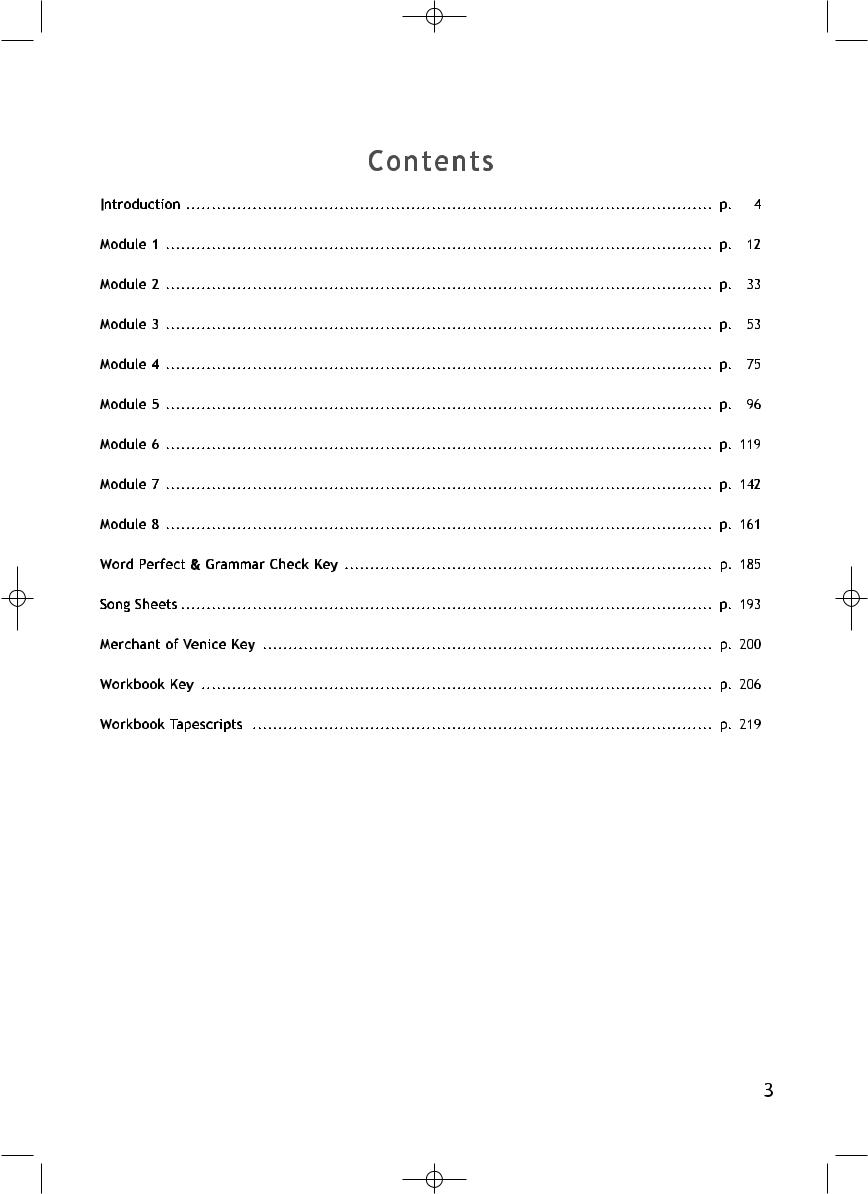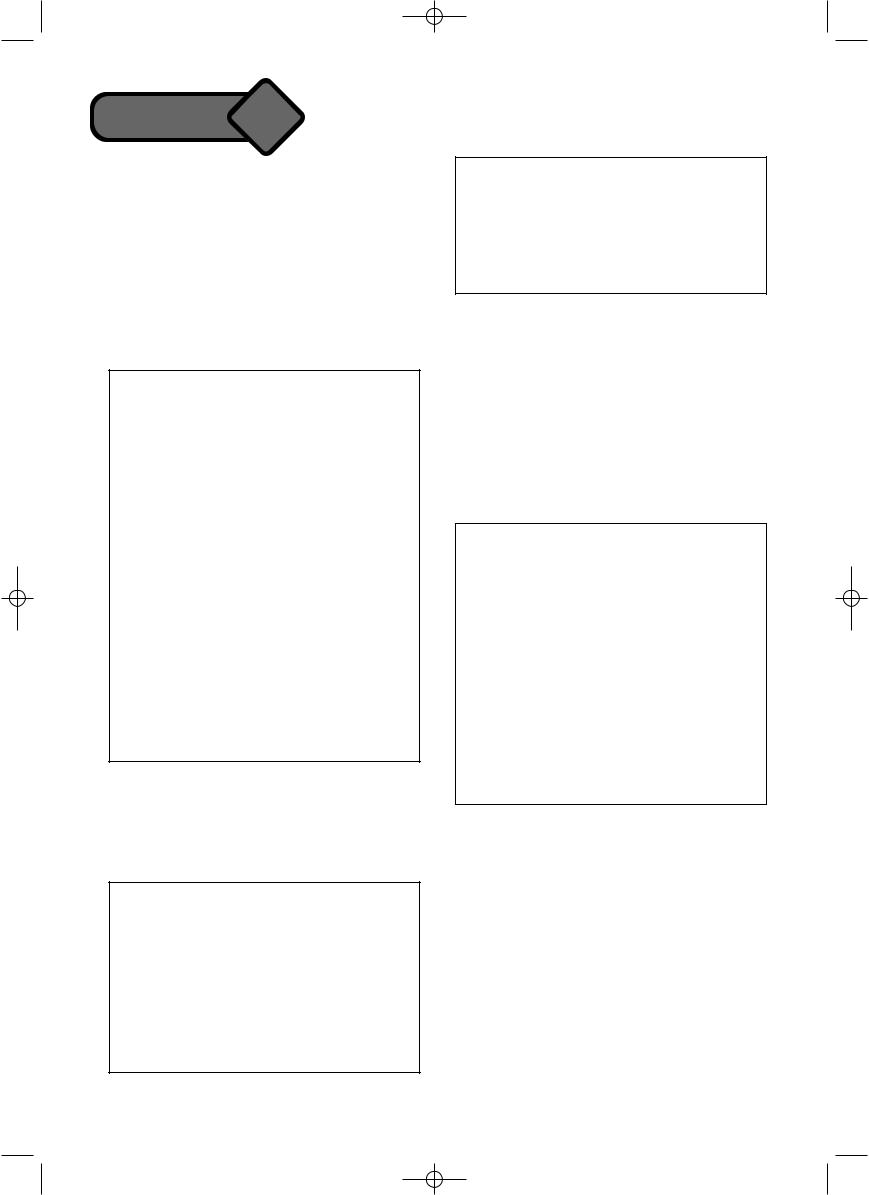
англ язык / Англ. яз. 10кл. Spotlight (Английский в фокусе). Teachers Book (с ответами к учебнику)_2009 -224c
.PDF
Translator’s Corners Key .................................................................................... |
p. 222 |

Spotlight 10 Intro Ts 12/3/08 12:12 PM Page 4
Introduction
Spotlight 10 is an English course based on the Common European Framework of Reference and designed for B2 level students.
Spotlight 10 develops all four skills (listening, speaking, reading and writing) through a variety of communicative tasks, and systematically recycles key language items. Above all, it is designed to promote active (activating all new vocabulary and structures in meaningful, everyday situations), holistic (encouraging the creative collective use of students’ brains as well as the linguistic analytical use of their brains) and humanistic (acquiring and practising language through stimulating tasks and topics, paying attention to their needs, feelings and desires) learning.
The coursebook consists of eight modules of nine lessons each. Each module is designed to be taught in eight 45-minute lessons. Each module ends with a Spotlight on Exams section as well as a Progress Check section. Moreover, the material presented in each module can be enhanced and consolidated through the Word Perfect, Grammar Check and Spotlight on Russia sections, to be found on pages 157 to 181 of the Student’s Book; the Spotlight on Russia section being a separate ten-page feature after the Word Perfect and Grammar check sections. We suggest that the material in these three sections as well as activities from the Workbook are assigned to students as homework. The Grammar Reference Section, including a list of the most common Irregular Verbs, can be used both by the teacher during the lesson when it is necessary to elaborate on a particular grammatical phenomenon and by the students at home in order to revise the material presented in class.
COURSE COMPONENTS
Student’s Book
The Student’s Book is the main component of the course. Each module is based on a single theme and the topics covered are of general interest. All modules follow the same basic structure (see
Elements of a Module).
Workbook
The Workbook is in full colour.
The Workbook contains units corresponding to those in the Student’s Book. It can be used either in class or for homework upon completion of the relevant unit in the Student’s Book. It aims to consolidate the language presented in the Student’s Book through a variety of exercises, incorporating all four skills.
My Language Portfolio
My Language Portfolio contains material to be used in a variety of tactile tasks throughout the course. This material is printed on pages which students may then cut out and file in their individual Language Portfolios (see Students’ Language Portfolios).
Teacher’s Book
The Teacher’s Book contains detailed Teacher’s notes, which provide:
ñobjectives of each unit in a clear and concise way
ñstep-by-step lesson plans and suggestions on how to present the material
ña full Key to the exercises in the Student’s Book and Workbook
ñtapescripts of all listening material
4

Spotlight 10 Intro Ts 12/3/08 12:12 PM Page 5
Class Audio CDs
The Class Audio CDs contain all the recorded material which accompanies the course.
Student’s Audio CD
The Student’s Audio CD contains the recorded dialogues and the main texts in the Student’s Book, and may be used for the purposes of homework, preparation and practice.
ELEMENTS OF A MODULE
Each module starts with a module presentation page to familiarise students with the language and patterns in the module. The module presentation pages also whet students’ appetites by familiarising them with some of the text types, pictures and activities found in the coming module. Each module contains the sections described below.
Vocabulary
Vocabulary is introduced in a functional and meaningful context, and is practised through a variety of exercises such as picture-word association and completing set phrases in order to help students use everyday English correctly. Further practice is provided in the Word Perfect section at the back of the book.
Reading
Dialogues
In each module there is a situational dialogue set in an everyday context in order to familiarise students with natural language. This dialogue also presents useful expressions so that students can practise everyday English.
Texts
Throughout each module there is a wide variety of reading texts such as e-mails, text messages, letters, articles, poems, etc, which allow skills such as reading for gist and reading for specific information to be systematically practised.
Grammar
The grammar items taught in each module are first presented in context, then highlighted and clarified by means of clear, concise theory boxes. Specific exercises and activities methodically reinforce students’ understanding and mastery of each item. There is a Grammar Reference section at the back of the Student’s Book which offers detailed explanation of each grammar point. Further practice is provided in the Grammar Check section at the back of the book.
Listening
Students develop their listening skills through a variety of tasks which employ the vocabulary and grammar practised in the module in realistic contexts. This reinforces students’ understanding of the language taught in the module. Many tasks included in the Student’s Book are multi-sensory, enabling students to practise all four language skills as they complete the task.
Speaking
Controlled speaking activities have been carefully designed to allow students guided practice before leading them to less structured speaking activities.
Pronunciation/Intonation
Pronunciation/Intonation activities help students to recognise the various sounds of the English language, distinguish between them and reproduce them correctly.
Everyday English
These sections provide practice in real-life communication skills and promote active learning. Standard expressions and language structures associated with realistic situations are presented through everyday situations and students are given the opportunity to fully activate the language taught.
5

Spotlight 10 Intro Ts 12/3/08 12:12 PM Page 6
Songs
There are song sheets at the back of the Student’s Book containing songs connected to the theme of the modules as well as related tasks. Listening to lively, high quality songs is a humanistic activity which lowers the students’ affective filters and allows them to absorb language more easily.
Games
These sections use the format of a team competition to consolidate the learning of vocabulary, expressions and grammar presented in the module. Games enable students to use new language in an enjoyable way and promote humanistic learning.
Study Skills
Brief tips, explanations and reminders, at various points throughout each module, help students to develop strategies which improve holistic learning skills and enable students to become autonomous learners of the English language.
Writing
In the fifth lesson of each module, students develop their writing skills through the use of all four language skills.
Guided practice of the relevant vocabulary is given and consolidated and followed by a model text which is thoroughly analysed.
Further Writing Practice
There are writing activities throughout the modules, based on realistic types and styles of writing, such as letters, descriptions, notes, postcards and articles.
Culture Corner section
In these interesting and informative pages, students are provided with cultural information and read about aspects of English-speaking countries which are thematically linked to the
module. The section also contains related tasks and creative projects, which give students the chance to process the information they have learnt and compare it to the culture of their own country.
Literature section
This section enables students to familiarise themselves with literature extracts from various authors in English and enlarge their vocabulary.
Across the Curriculum section
This section enables students to link the theme of the module to a subject on their school curriculum, thus helping them to contextualise the language they have learnt by relating it to their own personal frame of reference. These units contain lively and creative tasks which stimulate students and allow them to consolidate the language they have learnt throughout the module.
Going Green section
Through a variety of reading texts, these pages raise students’ awareness of environmental issues.
Spotlight on Exams
The purpose of this section is to offer students realistic practice in dealing with the types of tasks encountered in the Russian National Examinations. The tasks appearing here are Reading, Use of English, Writing, Listening and Speaking. module.
Progress Check
These sections appear at the end of each module, and reinforce students’ understanding of the topics, vocabulary and structures that have been presented. A marking scheme allows students to evaluate their own progress and identify their strengths and weaknesses.
6

Spotlight 10 Intro Ts 12/3/08 12:12 PM Page 7
Word Perfect
This section aims at recapitulating the key vocabulary of each module through a number of concise exercises.
Grammar Check
The exercises in this section present the students the chance to further practice the grammatical phenomena presented in the module, and also enable students to check for themselves the extent to which they have assimilated these phenomena.
Spotlight on Russia
These pages enable the students to further explore the themes introduced in each module, through interesting and informative passages which present people, places and situations the students are familiar with.
Grammar Reference
This is a thorough presentation of the grammatical phenomena that are presented in each module.
SUGGESTED TEACHING TECHNIQUES
A ― Presenting new vocabulary
Much of the new vocabulary in Spotlight 10 is presented by encouraging students to refer to the Word List or their dictionaries. Vocabulary is always presented in context, and emphasis is placed on collocations, phrasal verbs, idioms and word association, since memorising new words is easier when they are presented in lexical sets.
Further techniques that you may use to introduce new vocabulary include:
ñMiming. Mime the word to be introduced. For instance, to present dig, pretend you are digging and ask students to guess the meaning of the word.
ñSynonyms, opposites, paraphrasing and giving definitions. Examples:
―Present optimistic by giving a synonym: Tom is optimistic about his exam results, and his sister is hopeful too.
―Present exciting by giving its opposite: Tom doesn’t think computer games are exciting, he thinks they’re boring.
―Present siblings by paraphrasing it: Nancy doesn’t have any siblings. Nancy doesn’t have any brothers or sisters.
―Present viewer by giving a definition: A viewer is someone who watches something.
ñContext. Place vocabulary items in context with examples which make understanding easier and more complete. For instance, introduce the words wage and salary by referring to the amount of money someone is paid. Peter earns a weekly wage of £300, while his brother’s salary comes to £40,000 a year.
ñVisual prompts. Show photographs or drawings to make understanding easier.
ñUse of (bilingual/monolingual) dictionary.
Encourage students to guess the meaning of a word, then use their dictionaries to check if their guess is correct.
ñFlashcards. Make Flashcards out of magazine or newspaper pictures, photographs, ready drawings and any other visual material which may serve as vocabulary teaching tools.
ñUse of L1. In a monolingual class, vocabulary can be explained in the students’ mother tongue, although this method should be used only in moderation. Students also need to compare their mother tongue to the English language to find similarities and/or differences.
The choice of technique depends on the type of word or expression. For example, it may be easier to describe an action verb through miming, and not through a synonym or definition.
7

Spotlight 10 Intro Ts 12/3/08 12:12 PM Page 8
B ― Writing
All writing tasks in Spotlight 10 have been carefully designed to guide students to produce a successful piece of writing.
ñAlways read the model text provided and deal in detail with the vocabulary tasks. Students will then have acquired the language necessary to cope with the final writing task.
ñMake sure that students understand they are writing for a purpose. Go through the writing task in detail so that students are fully aware of why they are writing and who they are writing to.
ñIt would be advisable to complete the task orally in class before assigning it as written homework. Students will then feel more confident about producing a complete piece of writing on their own.
C ― Assigning homework
It is recommended that homework is regularly assigned and routinely checked according to the specific needs of the class.
When assigning writing tasks, prepare students as well as possible in advance. This will help them avoid errors and get maximum benefit from the task.
Commonly assigned homework tasks include:
ñVocabulary. Students memorise the meaning of words and phrases. Encourage students to remember the immediate context of the lexical items, or how these items collocate with other words.
ñSpelling. Students learn the spelling of particular words without memorising the text in which they appear.
ñReading aloud. Assisted by the Student’s CD, students practise at home in preparation for reading aloud in class.
ñWriting. After thorough preparation in class, students are asked to produce a complete piece of writing.
D ― Correcting students’ work
All learners make errors; they are part of the process of learning. The way errors are dealt with depends on the activity.
ñOral accuracy. In drill work correct students on the spot, either by providing the correct answer and asking them to repeat it, or by indicating the error but allowing students to correct it. Alternatively, indicate the error and ask other students to correct it.
ñOral fluency. In pairwork or free speaking activities allow students to finish the task without interruption, but make a note of the errors made and correct them afterwards.
ñWritten work. Do not over-correct; focus on errors that are directly related to the point of the exercise. When giving feedback you may write the most common errors on the board and help the class to correct them.
Remember that praising students and rewarding good work is of great importance.
E ― Class organisation
ñOpen pairs. The class focuses its attention on two students doing the assigned task together. Use this technique to provide an example of how the task should be done.
ñClosed pairs. Pairs of students work together on a task or activity, while the teacher moves around the classroom offering assistance and suggestions. Ensure the task is clearly understood before closed pairwork begins.
Stages in pairwork:
–Organise students into pairs
–Set the task and time limit
–Rehearse the task in open pairs
–Ask students to do the task in closed pairs
–Go around the class and help students
–Pairs report back to the class
8

Spotlight 10 Intro Ts 12/3/08 12:12 PM Page 9
ñGroupwork. Groups of three or more students work together on a task or activity. Class projects or role play are often most easily done in groups. Again, ensure students clearly understand the task in advance.
ñRolling questions. A student answers a question, then proceeds to ask a question directed at the next student in turn. This continues around the class.
F ― Using the Student’s Audio CD
All dialogues and texts in the Culture Corner and Extensive Reading sections are recorded on the Student’s CD. Students have the chance to listen to these recordings at home as many times as they want in order to improve their pronunciation and intonation. The suggested stages of such selfaccess study are:
ñThe student listens to the recording and follows the lines in the text or dialogue.
ñThe student listens to the recording with pauses after each sentence or exchange. The student repeats as many times as needed, trying to imitate the speaker’s pronunciation and intonation.
ñThe student listens to the recording again, then reads aloud.
STUDENTS’ LANGUAGE PORTFOLIOS
At the beginning of the course, students should be asked to obtain a suitable folder, or sectioned document wallet, which will hold their personal Language Portfolio.
This will be used to store not only the material cut out of the printed supplement, My Language Portfolio, but also a wide variety of other documents and material.
In practice, Language Portfolios may include projects or other written work; computer diskettes with work or drawings completed inside or outside the class; video cassettes with the students’ favourite story, filmed performances of songs, school plays, Evaluation Sheets and reports from teachers, various realia or pictures and so on. In short, it is a collection of what the learners want to keep as evidence of what they are learning through the medium of the English language.
This Language Portfolio is the student’s property. It is a tool to accompany the students’ language learning throughout the course and is suitable for documenting their learning both inside and outside the classroom. The main emphasis is on the process of learning, so that while compiling their Language Portfolios, learners develop the skill of working independently.
The aim of the Language Portfolio is to develop the learners’ autonomy. However, they should be guided at first on how to organise their work, keep records, access their own information, etc. Learners are usually willing to experiment and try new things, but at the same time, can be discouraged if they are not sure what is required of them. Once a routine has been established and learners begin to develop their autonomy, they can be given more responsibility and freedom. Learners will still appreciate feedback and appraisal though, so it is important that their efforts are monitored and facilitated.
First Steps
It is suggested that work on the Language Portfolio is started a few weeks into the course once students have made some progress in the English language. If students are not familiar with how to keep a Language Portfolio, at the beginning of the first session ask them to bring a folder, plastic
9

Spotlight 10 Intro Ts 12/3/08 12:12 PM Page 10
envelopes, etc. At the beginning of the first session, ask the students to turn to page three of their Language Portfolio. Go through the letter together, making sure that the students have a thorough understanding of the concept of the Language Portfolio. Encourage them to ask questions about anything they do not understand. Then give the students some time to arrange their Language Portfolio. Go around, providing any necessary help.
Once the students have arranged their Language Portfolio, go through each page together, commenting on the layout and pictures, and giving a brief explanation of the content of each page. Spend some time going through the Language Biography section, providing any necessary help. Once this has been completed, encourage the students to do the activities in the Dossier section.
How to approach each section
I)Language Passport
Read out the introductory paragraph as the students follow silently. Answer any questions they may have. Each time they are given something for this section, remind them to
make a record and file it in the appropriate section of their Language Portfolio.
II)Language Biography
Spend some time on each section, making sure the students know what is required of them. Here is a brief explanation of the rationale of each section:
―All about me: Students fill in their personal information and record their exposure to the English language.
―How I learn: Go through the section along with students, providing any necessary help. The purpose of this section is for both students and teacher to be able to determine each student’s individual learning style (i.e. visual, auditory, tactile/kinaesthetic) and needs.
―My World of English: By updating the record, students get a sense of achievement in the target language.
―Now I can: Students have the opportunity to assess their own learning. If a student moves to a new school his/her teacher will also be able to gauge this student’s level.
―Future Plans: Students record their intentions and ambitions concerning their improvement in the target language.
III)Dossier
The activities have been designed to reinforce the language covered in each module. They can be done upon completion of each module or at a time convenient to the teacher, provided that students have covered the corresponding module.
It is suggested that teachers participate in the activities by bringing in a completed version of an activity to be presented. Students need to be motivated and inspired, and the following is a suggestion on how to approach each activity. Every time students present an activity, give them due praise and attention, reward them with stickers, etc. In general, make them feel that they have done something special; in this way, all the class will be encouraged to do likewise.
TYPES OF LEARNING STYLES
Experienced teachers will be aware that some of their students learn best by listening to new information, some prefer to read about it, whereas other students need to do something with the new information. There is no absolute ‘best’ method of learning; these are all valid learning styles, as different people learn in different ways. Consequently, a coursebook should offer a variety of exercises and material which stimulate all types of learning style in order to help the learners learn according to their personal learning styles.
10

Spotlight 10 Intro Ts 12/3/08 12:12 PM Page 11
ñVisual Learners need to see the teacher’s body language and facial expression to fully understand the content of the lesson. They think in pictures and learn best from visual displays, including diagrams, illustrations, transparencies, videos, flashcards and handouts.
ñAuditory Learners learn best through verbal explanations, discussions, talking things through and listening to what others have to say. Written information may have little meaning until it is heard. They often benefit from reading a text aloud and using a tape recorder.
ñTactile/Kinaesthetic Learners learn best through a hands-on approach, actively exploring the physical world around them. They may find it hard to sit still for long periods and may become distracted by their need for activity and exploration. These learners express themselves through movement. They have a good sense of balance and hand-eye coordination. By interacting with the space around them, they are able to remember and process information. Involve them in role play, pairwork and other classroom activities.
ABBREVIATIONS
The following abbreviations are used in the Student’s Book and Teacher’s Notes:
Tteacher
S(s) |
student(s) |
HW |
homework |
L1 |
students’ mother tongue |
Ex. |
exercise |
p(p). |
page(s) |
e.g. |
for example |
i.e. |
that is |
etc |
et cetera |
sb |
somebody |
sth |
something |
pic |
picture |
11

Spotlight 10 Mod 01 Ts 12/4/08 1:00 PM Page 12
Module 1
Before you start …
Direct Ss’ attention to the title of the module, Strong ties. Elicit that it summarises the theme of how we relate to our friends and family, and our relationships with them.
Look at Module 1
In order to stimulate discussion and interest, ask Ss which page each picture is from. Then elicit other information (e.g. what the picture shows, what else Ss can see on the page and what they think the unit might be about).
Suggested Answer Key
Focus Ss’ attention on pic 1 (p. 9).
T: What page is picture 1 from? S1: It’s from page 12.
T: What can you see in picture 1? S2: Three friends playing.
T: What do you think this section will be about? S1: Probably about friendship, things to do with
friends, etc.
Pic 2 (p. 16)
What do you think the picture is about? How is it related to the title of the unit? What could be the relationship between these women/girls?
Pic 3 (p. 21)
What can you see in the picture? What do the other pictures show? What are the people wearing? What is their age?
Pic 4 (p. 11)
Who are these people? Who are the other people in the pictures?
Find the page number(s) for
Allow Ss time to browse through the units and find the relevant information. Then ask them to explain what each one is, and elicit simple information about each item.
Suggested Answer Key
a list of things to do (p. 14)
(a note that tells us what we must do in the day) What has Ann done? What hasn’t she done yet? Do you write a list of things to do?
an author’s biography (p. 16)
(an author’s biography is an account of an author’s life by someone else) Whose is this biography? How is it related to the chapter? Look at the picture of the woman. Does she look like an author? Why?
a single dictionary entry (p. 22)
(a dictionary entry is the definition of a word in a dictionary) How is the word you’ve chosen related to the unit?
a letter (p. 19)
(a long note to a friend) Who is this letter from? What is the letter about? Who is it written for?
Go through the rest of the sections with your Ss and point out that by the end of the module they will know how to perform the tasks listed.
Explain that the module has:
―a Literature section
―a Culture Corner
―an Across the Curriculum section
―a Going Green section
Ask Ss to look at the relevant pages and elicit what each section is about.
Suggested Answer Key
The Literature section seems to be about authors, books and literature extracts. This one (p. 16-17) is about Louisa May Alcott and an extract from her novel Little Women. Several activities are included to stimulate interest and explore this piece of literature.
The Culture Corner (p. 21) contains an article on teenage fashion in the UK.
The Across the Curriculum section (p. 22) looks at different types of discrimination, a topic in Citizenship.
The Going Green section looks at different green issues. This particular one (p. 23) deals with the recycling process.
Listen, read and talk about …/Learn how to …/ Practise …/Write/Make …
Select Ss to read through the list of items that will be covered in the module. Ask questions and give examples as appropriate. If necessary, explain any new vocabulary. Ask Ss to go through the list and put a tick next to the items that they think they know or can do, a cross next to the ones they don’t know or are not sure about, and a star next to the ones they think will be the most useful. Select Ss to report each item they have ticked or put a star next to.
12
